Yes that is called a "sleeve" and it can be a life-saver! I always recommend putting at least a 1" diameter pipe under any concrete or brick path or drive. You can duct tape the ends, and tape an irrigation flag on the ends for finding it later. Be sure the pipe is under the concrete (in base material) so you don't have a weak spot in the concrete.
Navigation
Install the app
How to install the app on iOS
Follow along with the video below to see how to install our site as a web app on your home screen.
Note: This feature may not be available in some browsers.
More options
You are using an out of date browser. It may not display this or other websites correctly.
You should upgrade or use an alternative browser.
You should upgrade or use an alternative browser.
My electrified poultry fencing arrived today... PICS page 2!!
- Thread starter chickenannie
- Start date
does an electric fence shock the birds on the inside? How do you keep them from hurting themselves?
Also, will this turn back a moose, dog, and occasional bear? I know it is not structural, but they would still get shocked and leave, right? Bears are a bit skiddish....

Also, will this turn back a moose, dog, and occasional bear? I know it is not structural, but they would still get shocked and leave, right? Bears are a bit skiddish....

I would beware of that fencing


- Thread starter
- #24
It does shock the birds, but it's good because then they stay away and don't get tangled in the fence (which is rare but possible, I've seen it with someone else's rooster). It doesn't hurt them, just gives them a "zing" --kinda like if you touch an electric fence. It is an unpleasant feeling more than a painful one.
Getting some consulting advice tommorrow about doing the wiring ... thank god! The birds are still free ranging, in the meantime.



Getting some consulting advice tommorrow about doing the wiring ... thank god! The birds are still free ranging, in the meantime.



Last edited:
- Thread starter
- #25
I had help to build this new chicken roost in preparation for moving the chickens in here next to their new penned in area. It looks so cozy in there!
The 4-nest box I bought is to the left. The new Roost is to the right and is all scavenged wood pieces (cuz I hate to buy new stuff). Should I apply some kind of linseed oil or something on it to keep mites away? Any suggestions for what to put underneath to make poop removal easier? I can lift it out easily and I put lots of hay underneath.
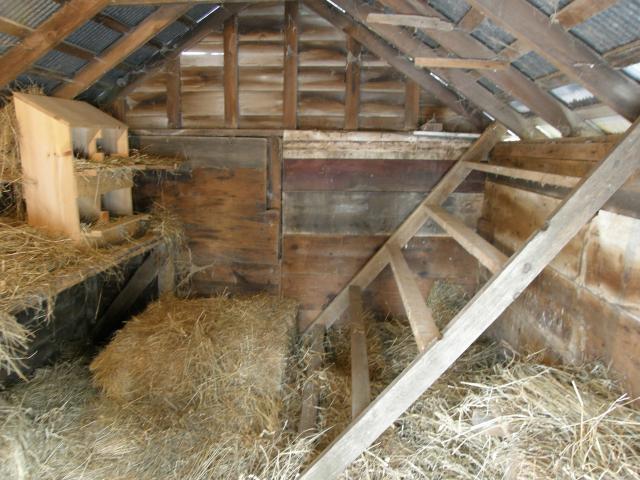
The 4-nest box I bought is to the left. The new Roost is to the right and is all scavenged wood pieces (cuz I hate to buy new stuff). Should I apply some kind of linseed oil or something on it to keep mites away? Any suggestions for what to put underneath to make poop removal easier? I can lift it out easily and I put lots of hay underneath.

- Thread starter
- #26
Here's some pics of the electrified netting components ... I installed the charger (a P5) in the door frame of the feed shed so it would stay dry. On the frickin coldest and windiest day of winter with the help of another guy, we dug a tiny trench in the frozen road bed so the insulated cable that will connect the two different fenced areas could be underneath the road. I put a 1" pvc pipe around it under the roadbed, but it was too frozen to dig any deeper than that and took a heck of a lot of effort even to get that tiny 4" deep trench! The ends of the cable just poke up out of the ground and lie across the grass... It is too frozen now to go to all the effort of embedding it below ground the entire length.
Electric fence charger
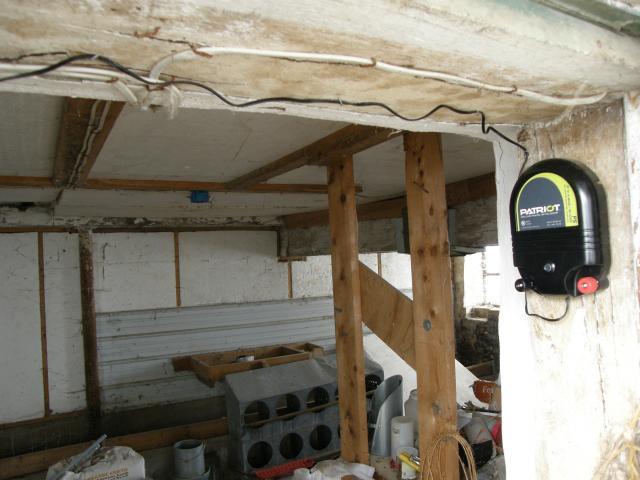
The trench (covered up) where the cable now lies:
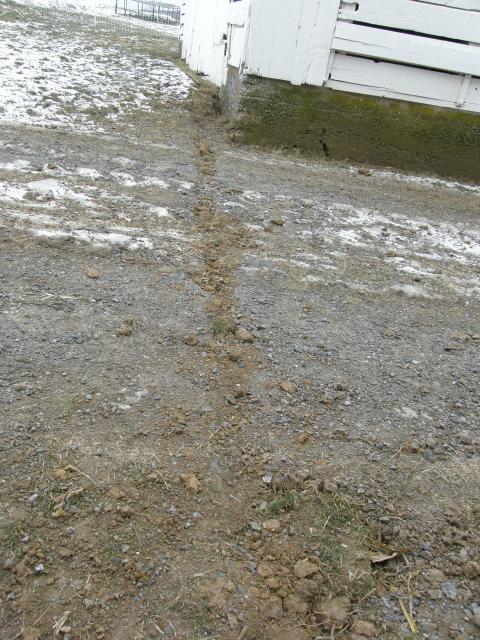
Here's what the cable looks like just popping up from the trench. This will get hooked onto the end of the netting post at the metal tab.
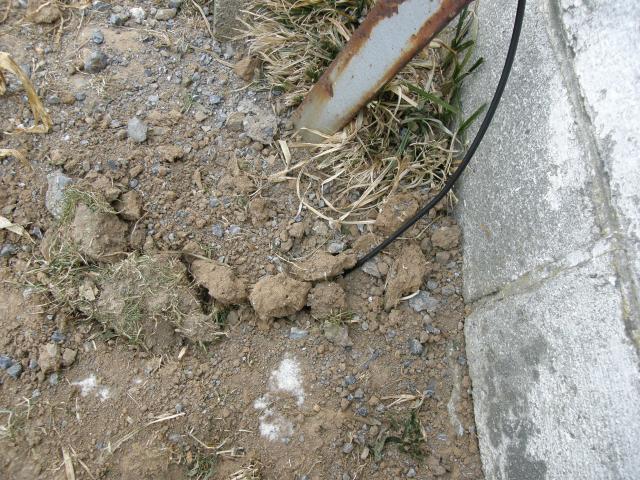
You can kind of see the fencing here. The coop is the little shed in the middle. The chooks will have to walk through a 2 ft. corridor between the buildings to get to their run. Any suggestions for keeping the ground in decent condition for the next 2 months, till I move them out to pasture?
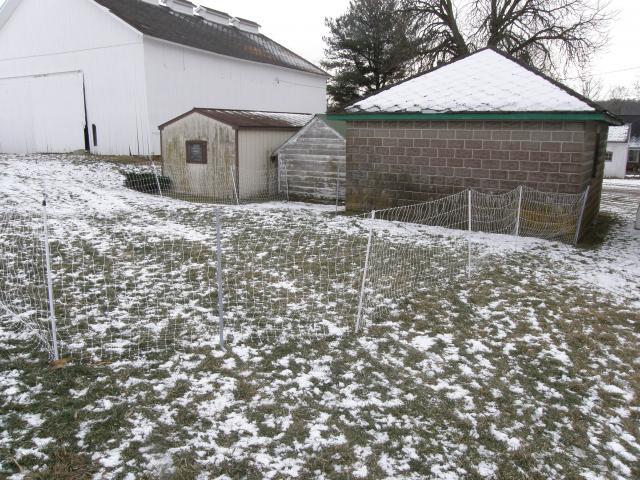
Electric fence charger

The trench (covered up) where the cable now lies:

Here's what the cable looks like just popping up from the trench. This will get hooked onto the end of the netting post at the metal tab.

You can kind of see the fencing here. The coop is the little shed in the middle. The chooks will have to walk through a 2 ft. corridor between the buildings to get to their run. Any suggestions for keeping the ground in decent condition for the next 2 months, till I move them out to pasture?

Last edited:
Isn't that stuff great? Just be careful to test it FREQUENTLY (like, in your situation I'd do it every morning without fail), because it will not carry a proper charge if there is snow or you've had an ice storm, and also shallowly-buried trenched-in lines are notorious for being breached and grounding out. You're going to put in wire from charger to a ground rod too, yes? (just wondering since I only see the one wire)
To keep the ground in the space between buildings in good shape, you might want to lay down wood chips or something like that (ideally NOT shavings, unless you have no other option) to absorb some of the poo and to keep them from churning it to mud once the ground thaws. You could probably wait til there IS a thaw if necessary, but if you put it down now it will start intercepting poo now, which would be valuable. You may have to shovel out some of it if it gets wet and stinky and replace with new material, but it will keep the underlying ground from being overly trashed til summertime. Same with any spots out in the paddock that start going to mud.
Good luck, have fun,
Pat
To keep the ground in the space between buildings in good shape, you might want to lay down wood chips or something like that (ideally NOT shavings, unless you have no other option) to absorb some of the poo and to keep them from churning it to mud once the ground thaws. You could probably wait til there IS a thaw if necessary, but if you put it down now it will start intercepting poo now, which would be valuable. You may have to shovel out some of it if it gets wet and stinky and replace with new material, but it will keep the underlying ground from being overly trashed til summertime. Same with any spots out in the paddock that start going to mud.
Good luck, have fun,
Pat
- Thread starter
- #28
Quote:
Pat, Thanks for the tips on testing and for the bedding.
I thought the fence was supposed to be snow and ice-proof, so it's good to know I should test it.
I am putting a separate cable to the ground (I hadn't hooked it up yet in the photo of the charger). what do you mean about shallow buried trenched lines "grounding out". She had said to bury it 15 inches, but with the frozen road, it was absolutely impossible to go deeper than 4 inches. Will having it in PVC pipe help or make it worse?
Pat, Thanks for the tips on testing and for the bedding.
I thought the fence was supposed to be snow and ice-proof, so it's good to know I should test it.
I am putting a separate cable to the ground (I hadn't hooked it up yet in the photo of the charger). what do you mean about shallow buried trenched lines "grounding out". She had said to bury it 15 inches, but with the frozen road, it was absolutely impossible to go deeper than 4 inches. Will having it in PVC pipe help or make it worse?
Quote:
It is only snow and ice proof in the sense that they won't break it. They will still a) sag badly under weight, grounding the fence out; b) develop a conductive connection with the ground when there is ice (freezing rain) or heavy wet snow on the fence, grounding it out; and c) if the soil is frozen or very snow-covered, animals touching the fence don't have as good a connection to earth and thus conduct less current, encountering less "zap". These are all features of ANY electric fence (esp. the last one); the electronet is somewhat worse than other electric fences about the first two things, just b/c it is floppier and has more strings and they're closer to the ground.
Honestly electronet is not a recommended *year-round* fence in snowy areas, for precisely those reasons; it should work fine for you as long as you decide whether to use it depending on the weather and depending on how it tests out on any given morning.
It is only snow and ice proof in the sense that they won't break it. They will still a) sag badly under weight, grounding the fence out; b) develop a conductive connection with the ground when there is ice (freezing rain) or heavy wet snow on the fence, grounding it out; and c) if the soil is frozen or very snow-covered, animals touching the fence don't have as good a connection to earth and thus conduct less current, encountering less "zap". These are all features of ANY electric fence (esp. the last one); the electronet is somewhat worse than other electric fences about the first two things, just b/c it is floppier and has more strings and they're closer to the ground.
Honestly electronet is not a recommended *year-round* fence in snowy areas, for precisely those reasons; it should work fine for you as long as you decide whether to use it depending on the weather and depending on how it tests out on any given morning.
what do you mean about shallow buried trenched lines "grounding out". She had said to bury it 15 inches, but with the frozen road, it was absolutely impossible to go deeper than 4 inches. Will having it in PVC pipe help or make it worse?
Buried electric-fence lines are notorious for having their insulating covering breached (usually it happens "eventually" rather than right away, due to traffic over the area mashing the cable down against a sharp bit of rock or whatever) at which point you have a live connection to the ground. This grounds the fence out (so it will have little or no zap) and can also cause animals to refuse to step on the ground near where the problem is (with horses and cattle, often the first you know about it is when they suddenly start refusing psychotically to go through a gateway where a wire is buried
 ). PVC will help if it's only a foot-traffic area, but it will not do much against vehicular traffic and honestly from horse-farm experience I think that heavy-duty rubber hose is actually a better burial 'conduit' to go under roads... not something to worry about now, but something to consider when you dig it up and put it deeper once Springtime comes.
). PVC will help if it's only a foot-traffic area, but it will not do much against vehicular traffic and honestly from horse-farm experience I think that heavy-duty rubber hose is actually a better burial 'conduit' to go under roads... not something to worry about now, but something to consider when you dig it up and put it deeper once Springtime comes.
I'm totally not criticizing -- as you say, a shallow trench is really about all you can DO when the ground is frozen!
 -- all I'm saying is, it's another reason to put a good accurate fence tester (ideally one of the digital models, even though yes they're pricier, rather than the sadly-inaccurate four-neon-lights thingies) on the fence EVERY morning before you turn the chickens out. You need about 4-5,000 volts to reliably keep dogs and similar predators out.
-- all I'm saying is, it's another reason to put a good accurate fence tester (ideally one of the digital models, even though yes they're pricier, rather than the sadly-inaccurate four-neon-lights thingies) on the fence EVERY morning before you turn the chickens out. You need about 4-5,000 volts to reliably keep dogs and similar predators out.
Electric fences are great, you just have to realize and respect their idiosyncrasies

Good luck, have fun,
Pat
Buried electric-fence lines are notorious for having their insulating covering breached (usually it happens "eventually" rather than right away, due to traffic over the area mashing the cable down against a sharp bit of rock or whatever) at which point you have a live connection to the ground. This grounds the fence out (so it will have little or no zap) and can also cause animals to refuse to step on the ground near where the problem is (with horses and cattle, often the first you know about it is when they suddenly start refusing psychotically to go through a gateway where a wire is buried

I'm totally not criticizing -- as you say, a shallow trench is really about all you can DO when the ground is frozen!

Electric fences are great, you just have to realize and respect their idiosyncrasies

Good luck, have fun,
Pat
- Thread starter
- #30
Thanks, Pat. The whole electrified fencing thing is very new to me and I'm still grasping how it actually works. I also realized people are not going to realize it is electric and may touch it. I'll be hanging the signs on the fence, but I can't be guaranteed that people will actually read them. The company had said 2-3,000 volts was plenty. My predators would be few, but possibly foxes and neighbor's dogs as the worst. I lock the birds inside at night, so, they're safe then anyways.
New posts New threads Active threads
-
Latest posts
-
-
4 wk old Salmon Faverolle mix.....pullet or cockerel?
- Latest: curiousheart3
-
-
-
-
Latest threads
-
-
-
-
Low weight after vent gleet
- Started by hanneke
- Replies: 2
-
-
-
Threads with more replies in the last 15 days
-
-
Question of the Day - Thursday, August 14th, 2025
- Started by casportpony
- Replies: 69
-
Ended BYC Poultry Caption Contest 08-08-25 Pic by Molpet
- Started by TwoCrows
- Replies: 62
-
-
Still no idea what’s going on with my hens comb and growing black spots
- Started by Ohsrsly
- Replies: 54
-
×
